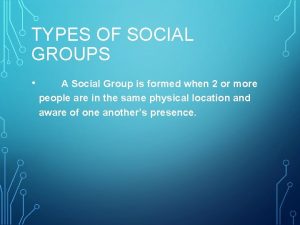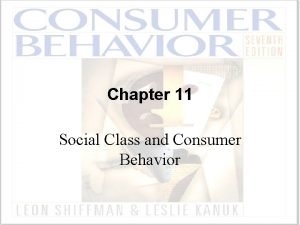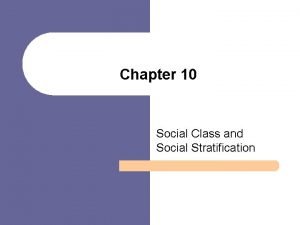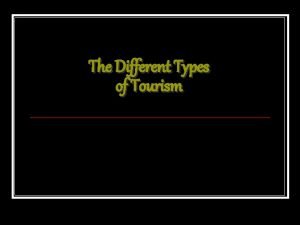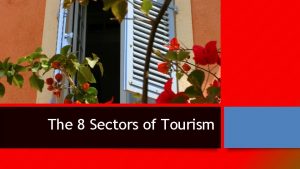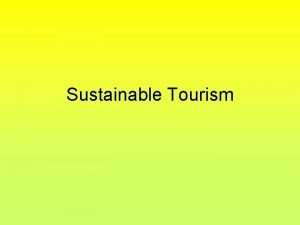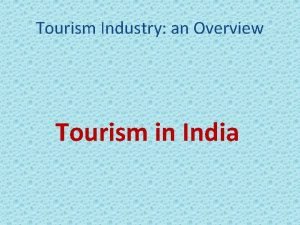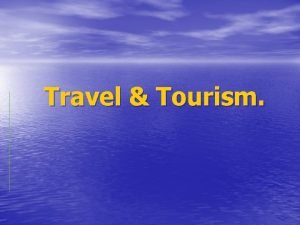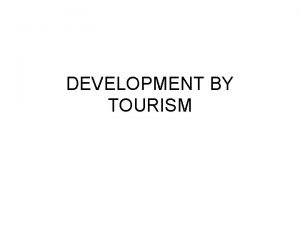DIFFERENT TYPES OF TOURISM Part II SOCIAL TOURISM
















- Slides: 16

DIFFERENT TYPES OF TOURISM )Part II(

SOCIAL TOURISM • • • In general, holiday market is a commercial market. . . meaning…consumers have to pay full price for their vacation. However, in a number of countries, tourism and holiday-taking is also encompassed within the realms of welfare policy. Meaning, holidays are subsidized by government or voluntary sector agencies. • Cheques-Vacances use to exchange with tourism service. • Social tourism holiday villages

SOCIAL TOURISM • In recent year, social tourism also try to provide a better service for groups in society who have been ignored or discriminate against. 1) Disability consumers: mobility problems, impaired sight or hearing difficulties. 2) Single-parent families: when there is a stipulation of family meaning two adults and children. • Encouraging ‘ethic minority’ to participate in tourism market.

EDUCATIONAL TOURISM • Start from Greek & Roman elites travelled to increase their understanding of the world. • In recent decades, educational tourism represents in form of…. 1. Student Exchanges: people travel to other countries to study and learn more about the culture and language of other people. 2. Young People attending language classes in a foreign country 3. Special Interest holidays: people’s main motivation for taking trip is to learn something new. E. g. cookery classes, language classes • This market is strong among ‘retired people’=‘empty-nesters’

CULTURAL TOURISM • Visits to heritage attractions, destinations, and attendance at traditional festivals. • A desire to sample national, regional or local food and wine • Sporting events • Visiting farms or craft center

SCENIC TOURISM • • • To view spectacular natural scenery Influence by the Romantic Movement in the Arts. Scenic tourism grew dramatically in the last century in both Europe, particularly in the Alps, and in USA. • Mountains, water-related scenery, lake, coastal scenery

• • • HEDONISTIC TOURISM Motivated by a desire for sensual pleasure The classic four ‘S’s’ of • sea • sand • sun • sex. Negative impact to both tourists and host community. • E. g. Pattaya, Thailand

ACTIVITY TOURISM • Growing concerns such as health and fitness • Using modes of transport to tour areas which require effort on the part of the tourist, such as walking, cycling and riding. • Participating in land based sports such as golf and tennis • Taking part in water-based activities such as diving and wind-surfing.

SPECIAL INTEREST TOURISM • A niche market acting like activitytourism, but differs in that it involves little or no physical exertion – Painting – Gastronomy: cooking and enjoying gourmet meals – Music festival

SPECIAL INTEREST TOURISM • A niche market acting like activity-tourism, but differs in that it involves little or no physical exertion § § § Painting Gastronomy: cooking and enjoying gourmet meals Music festival

THE BACKPACKER • Backpacker: tourists who use a rucksack or backpack for their trip • They tend to… • • Being independent rather than packaged travel Desire to keep expenditure to a minimum Try to get off the beaten tourists track Extend the trip beyond the usual duration of one or two weeks of a normal holiday. • ‘Inter-railer’ : backpackers who travel across by rail • Most backpackers are usually students who have long vacations

THE BACKPACKER • Can be people taking a year out before begin their colleges or after college graduation • Popular among young people from developed countries, e. g. US, UK, Netherlands, Germany, Australia, and Japan • Backpacker is an early example of global tourist - - as they share similar behavior (stay in the same accommodation and visit the same attraction )regardess of their nationality - partly due to backpackers share the same source of travel media, e. g. travel guide suchas ‘ Lonely Planet’ • Future : • Likely to grow more due to growing number of students around the world • However, Unlikely to become popular with other groups because most people in employment have limited paid holiday • Could be another option for early retired people who want to be more adventurous

EXCURSIONISTS AND DAY-TRIPPER • Excursionist is generally a domestic tourist and is the core market for visitor attractions, many seaside resorts and some rural areas • Does not travel too far as they only have one day or less available • Involving with less planning for trip • Car-based market • Excursionist can also be in terms of international • E. g. Malaysians shop in Singapore, Swiss people shop in Milan • Excursionists or day- trippers are also major consumers of food and drink services so as considerable use of leisure shopping facilities

THE SNOWBIRD MARKET • 2 characteristics of snowbird tourists 1) The trip are of long duration, from four weeks to four months 2) They are normally taken by ‘retired people’ • The motivation of taking snowbird trip are… • • To escape the cold weather in their own country To reduce their expenditure on heating at home To improve their health that they may suffer from cold To make new friends and have a less lonely life

THE SHORT-BREAK TOURISM • Emerge because of …. • the growth of the five-day week with a full two-day weekend • Increase of car ownership/ faster aircraft • E. g. romantic weekend for a couple to Rome and Paris, shopping trip to Hong Kong, Paris, VFR trips, health spa breaks, special interest trips, etc. ,

ETHNIC MINORITY TOURISTS • They are ethnic communities staying within a particular country • May have been in the country for generations & often maintain contact with their original country • Have their own patterns of tourism and tourism infrastructure • In many developed countries, few people from this group are regular purchasers for the mainstream tourism Industry - - due to lack of disposable income • Future: • Growing in numbers of this group in various countries & they are becoming more integrated and gain greater economic power , therefore, we shall see rise in numbers of them joining the mainstream market in the near future
 Types of tourism
Types of tourism Different types of tourism
Different types of tourism Social groups types
Social groups types Different types of social groups
Different types of social groups Different types of social groups
Different types of social groups Social class and consumer behavior
Social class and consumer behavior Types of social satisfaction
Types of social satisfaction Classification of social group
Classification of social group Mass tourism vs alternative tourism
Mass tourism vs alternative tourism Social thinking and social influence in psychology
Social thinking and social influence in psychology Social thinking social influence social relations
Social thinking social influence social relations What are the 8 tourism industry sectors
What are the 8 tourism industry sectors Thermosoftening plastics examples
Thermosoftening plastics examples Flame test principle
Flame test principle Sound will travel at different speeds in different mediums.
Sound will travel at different speeds in different mediums. Sound travels fastest through
Sound travels fastest through Cultural relarivism
Cultural relarivism


